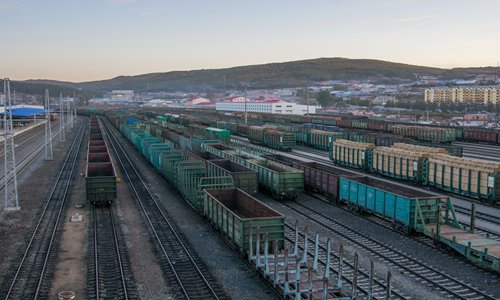
Russian freight cars containing timber in Suifenhe, a major Chinese border city with Russia, on September 26, 2018 Photo: IC
The Chinese timber industry is diversifying its import sources to ease the impact of the suspension of Australian timber imports after quality hazards were spotted last December, the Global Times learned.
Several timber suppliers told the Global Times on Sunday that although the suspension has created a supply-demand gap, this can be overcome in the long run by increasing imports from other trading partners such as Russia and Canada.
The halt on Australian timber supplies has had some impact in China, where demand is booming. The supply gap in timber for construction use is about 30 percent nationwide, Pan Jinzhi, a sales manager at a timber import and processing company based in Erlian, North China's Inner Mongolia Autonomous Region, told the Global Times on Sunday.
Timber prices are at historic highs, with gains of up to 110 yuan ($16.9) per cubic meter, open data showed.
However, industry participants said that this situation will be temporary as imports from other countries and China's own production make up the gap.
"The Australian timber import suspension will have a limited impact on our timber consumption in the long run, because although Australian timber is cheaper than Russian timber, it is of inferior quality," said Pan.
High prices reflect falling global timber harvests and logistics hurdles posed by the pandemic, coupled with rising demand for timber and other raw materials, as China resumes production, Yu Zhiming, general manager of Today Trade Co in Suifenhe, which imports wood from Russia, told the Global Times.
"Chinese companies can make up the shortfall by importing timber from places like Russia and Ukraine," said Yu, noting that at his company, Russian timber imports increased after the Spring Festival. The total import volume of birch and pine wood increased by 10-20 percent year-on-year.
The impact would be much greater on the Australian side than the Chinese side, industry participants said.
As the largest destination market for Australian timber, China imports 4 million tons of log and pulped timber every year, accounting for about 90 percent of Australia's timber exports worth $A1.6 billion.
Reuters reported Friday that "Australia is bracing from a drawn-out disruption to its A$1.6 billion ($1.23 billion) annual timber trade with China after requests to Beijing's customs officials to resume the log exports were ignored," citing two unidentified sources.
"It is hard to say when [things will change] since we should look at this matter from the viewpoint of normal trade procedures. There are some issues concerning Australian timber. Some of it does not meet import standards or inspection and quarantine procedures," Song Wei, an associate research fellow at the Chinese Academy of International Trade and Economic Cooperation, told the Global Times on Sunday, noting that China also expects the issue to be resolved, but that depends on the Australian side.
Despite the short-term impact on China's processing industry, the construction of projects under the Belt and Road Initiative and the upgrading of domestic industries will mean a gradual decline in import dependence on Australian timber, said Song.




